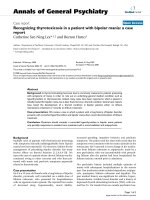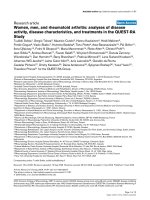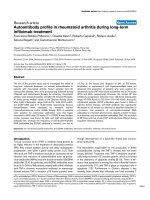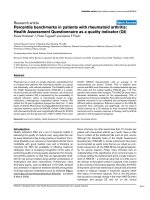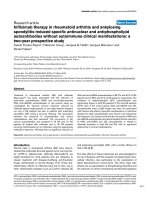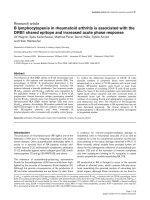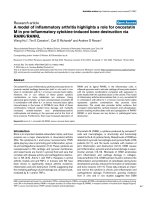Báo cáo y học: "Bone erosions in rheumatoid arthritis can be repaired through reduction in disease activity with conventional disease-modifying antirheumatic drugs." pot
Bạn đang xem bản rút gọn của tài liệu. Xem và tải ngay bản đầy đủ của tài liệu tại đây (619.96 KB, 10 trang )
Open Access
Available online />Page 1 of 10
(page number not for citation purposes)
Vol 8 No 3
Research article
Bone erosions in rheumatoid arthritis can be repaired through
reduction in disease activity with conventional disease-modifying
antirheumatic drugs
Haruko Ideguchi
1
, Shigeru Ohno
1
, Hideaki Hattori
1
, Akiko Senuma
2
and Yoshiaki Ishigatsubo
3
1
Intractable Disease Center, Yokohama City University Medical Center, Yokohama, Japan
2
Department of Rheumatology, Yokohama Minami Kyousai Hospital, Yokohama, Japan
3
Department of Internal Medicine and Clinical Immunology, Yokohama City University Graduate School of Medicine, Yokohama, Japan
Corresponding author: Haruko Ideguchi,
Received: 9 Aug 2005 Revisions requested: 14 Oct 2005 Revisions received: 24 Feb 200
6 Accepted: 21 Mar 2006 Published: 28 Apr 2006
Arth
ritis Research & Therapy 2006, 8:R76 (doi:10.1186/ar1943)
This article is online at: />© 2006 Ideguchi et al.; licensee BioMed Central Ltd.
This is an open access article distributed under the terms of the Creative Commons Attribution License ( />),
which permits unrestricted use, distribution, and reproduction in any medium, provided the original work is properly cited.
Abstract
We conducted the present study to determine whether repair of
erosions occurs in patients with rheumatoid arthritis (RA)
treated with conventional disease-modifying anti-rheumatic
drugs (DMARDs) and to compare clinical characteristics
between patients exhibiting and not exhibiting erosion repair.
We included in the study a total of 122 RA patients who fulfilled
the 1987 American College of Rheumatology criteria for RA; all
patients had paired sequential radiographs of both hands and
wrists showing erosive changes at baseline. Patients were
classified into two groups according to the presence of repair of
erosions at follow up, namely the 'repair observed' and 'repair
not observed' groups. Clinical characteristics, disease activity,
radiographic scores and treatment in the two groups were
compared. Forty-four repairs were observed in 13 patients
(10.7%). Compared with the repair not observed group, the
functional class of the patients in the repair observed group was
lower at baseline (P < 0.01) and the mean disease activity was
lower at follow up (P < 0.005). The changes in radiographic
scores per year (total radiographic score and erosion score)
were lower (P < 0.05 and P < 0.01, respectively) in the repair
observed group. No difference in treatment was observed.
Repair of erosions was detected in 10.7% of RA patients
treated with conventional DMARDs. Repairs were associated
with low functional class at baseline and low disease activity at
follow up. These observations support the importance of
reduction in disease activity in RA patients. Because repair of
erosions was detected in a substantial number of patients,
assessment of erosion repair should be incorporated into the
radiographic evaluation and scoring of RA.
Introduction
Rheumatoid arthritis (RA) is a chronic, destructive autoimmune
inflammatory disorder of unknown aetiology that occurs in
about 1% of the adult population [1].
The radiograph has evolved into the 'gold standard' for evalu-
ation of RA progression because it best demonstrates the ana-
tomical destruction of joint structures [2]. However, repair of
erosions or reparative changes in RA have rarely been
reported [3-10]. There are several possible reasons for this.
First, radiographs are rarely obtained in patients who appear
to be experiencing remission, in whom repair phenomena may
be observed. Second, most clinical trials are conducted in
patients with longstanding destructive RA with high disease
activity, and in such cases it is difficult to define repair clearly.
Third, there is an interval between clinical findings and corre-
sponding radiographic phenomena in clinical trials, and most
clinical trials have insufficient follow up to identify repair phe-
nomena. Fourth, the most commonly used scoring methods,
namely those of Sharp and Larsen and their groups, are not
designed to describe reparative changes. The Sharp/van der
Heijde method includes 16 areas for erosions and 15 for joint
space narrowing in each hand. The erosion score per joint can
range from 0 to 5. Joint space narrowing is scored with range
from 0 to 4. The maximum erosion score of all joints in both
hands is 160 and the maximum score for joint space narrowing
DAS = Disease Activity Score; DMARD = disease-modifying antirheumatic drugs; JSN = joint space narrowing; MRI = magnetic resonance imaging;
PIP = proximal interphalangeal; RA = rheumatoid arthritis; vdH-S = the van der Heijde modification of the total Sharp scoring system.
Arthritis Research & Therapy Vol 8 No 3 Ideguchi et al.
Page 2 of 10
(page number not for citation purposes)
in all joints of both hands is 120. Finally, serial high-quality radi-
ographs must be obtained to permit detection of repair.
In recent years considerable advances have been made in the
pharmacological management of RA [11]. Previously, the
mainstays of treatment for RA were disease-modifying
antirheumatic drugs (DMARDs), which suppress the inflam-
matory process and slow disease progression. Today's biolog-
ical agents are specifically designed to block key mediators of
the RA inflammatory process.
Recent trials with tumour necrosis factor-α blocking drugs in
RA have demonstrated improvements in radiographic scores,
suggesting drug-induced repair of erosions [12-14]. These
findings have renewed interest in the radiographic detection of
repair, and Sharp and coworkers [15] instituted a subcommit-
tee of the OMERACT (Outcome Measures in Rheumatology)
Imaging Committee in a first attempt to confirm whether repair
occurs in RA and, if so, to determine how repair should be
assessed. They provided evidence that repair of bone damage
does occur in RA, resulting in some degree of improvement,
which was recognized by the majority of a panel of experts. A
consensus on definitions for the morphological features of
repair was achieved for the following: sclerosis, cortication, fill-
ing-in, remodeling and restoration [15].
We wondered whether repair of erosions can be detected in
the real world setting among RA patients who have longstand-
ing arthritis, who do not achieve remission easily. To examine
whether repair of erosions in RA patients treated with conven-
tional DMARDs can be detected, we examined 122 RA
patients with paired sequential radiographs of both hands and
wrists. We also assessed the clinical characteristics of these
patients.
Table 1
Characteristics of the study population
Characteristic Group P value
Repair observed Repair not observed
Patients (n)13109
Female (n [%]) 10 (76.9%) 93 (85.3%) NS
a
Age (mean [range]; years) 64.2 ± 9.8 (39–78) 60.6 ± 12.6 (22–85) NS
b
Disease duration (mean [range]; years) 12.5 ± 9.6 (2.7–38) 14.3 ± 10.8 (1–45) NS
c
RF positivity (n [%]) 11(84.6%) 85(78.0%) NS
a
Dosage of prednisone (mean [range]; mg) 2.0 ± 2.1 (0.0–6.0) 3.7 ± 3.3 (0.0–14.5) NS
c
Prescribed bisphosphonate (n [%]) 8 (61.5%) 79 (72.5%) NS
a
Functional class
I 4 10 <0.01
c
II 978
III 0 18
IV 0 3
RA stage
I 00NS
c
II 436
III 2 19
IV 7 54
DAS28-3 score at baseline (mean [range]) 4.4 ± 1.2 (2.7–6.0) 4.0 ± 1.1 (1.0–7.0) NS
b
DAS28-3 score at follow up (mean [range]) 2.7 ± 1.1 (1.5–5.4) 3.7 ± 1.2 (0.2–8.1) <0.005
b
∆DAS28-3 (mean [range]) -1.7 ± 1.2 (-3.5 to +0.1) -0.3 ± 1.0 (-2.4 to +2.6) <0.001
b
Time interval between pairs of radiographs, years (mean [range]) 2.3 ± 1.0 (1.4–3.1) 1.6 ± 1.8 (1.0–1.6) NS
b
∆DAS28-3/year (mean [range]) -0.9 ± 0.8 (-2.6 to +0.1) -0.2 ± 0.9 (-2.8 to +3.4) <0.01
b
RA functional status was determined using American College of Rheumatology criteria, and RA stage was determined using Steinbrocker criteria.
a
Fisher's exact probability test;
b
Student's t test;
c
Mann-Whitney U test. DAS, Disease Activity Score; RF, rheumatoid factor.
Available online />Page 3 of 10
(page number not for citation purposes)
Materials and methods
Patients
All patients were diagnosed with RA according to the 1987
American College of Rheumatology criteria for RA. From
among RA patients seen in the rheumatology clinic by two of
the authors (HI and SO) at Yokohama City University Medical
Center between January 2001 and March 2004, patients with
paired sequential radiographs of both hands and wrists were
enrolled in this study.
Clinical evaluation
Clinical characteristics, including patient's sex, age, disease
duration, rheumatoid factor status, prescription (dose of pred-
nisone, bisphosphonates and DMARDs such as methotrexate
and sulfasalazine), functional class (determined using Ameri-
can College of Rheumatology criteria) and RA stage (deter-
mined according to Steinbrocker criteria), were recorded.
Disease activity was assessed using the Disease Activity
Score (DAS) in 28 joints, DAS28-3. Modifications to the orig-
inal DAS index have been applied, yielding the DAS28 (which
is a composite index that includes variables such as the
number of tender and swollen joints using 28 joint counts,
erythrocyte sedimentation rate (ESR), and the patients'
assessment of disease activity) and DAS28-3 (excluding
patients' assessment of disease activity from DAS28) indices;
these indices have been and validated and, for reasons of sim-
plicity, are preferred over the original index in clinical practice
[16-18]. The DAS28-3 value was calculated as follows:
DAS28-3 score = (0.56 × + 0.28 ×
+ 0.7 × ln[erythrocyte sedimentation
rate]) × 1.08 + 0.16.
Radiographic evaluation
Detection of repair of erosions
Standard radiographs of the hands and wrists were obtained
in two planes (anteroposterior and oblique projections). Radi-
ographic examinations were interpreted independently by two
board-certified rheumatologists with musculoskeletal reading
experience (HI and SO). The films were reviewed to identify
erosion repair specifically. Bone erosion was defined as a dis-
crete interruption of the cortical surface, based on standard
plain film radiograph criteria [19,20]. The films were evaluated
with known sequences in order to ensure maximum sensitivity
in detecting erosion repair [21,22]. The evaluators were
blinded to patient identity. Repair was defined as follows [10]:
category 1, reappearance of the cortical plate at a bone site
where it had been destroyed; category 2, partial or complete
filling in of an erosion; and category 3, subchondral bone scle-
rosis and osteophyte formation (secondary osteoarthritis).
Where there was a difference in opinion regarding whether
repair was present, these cases were discussed until agree-
ment was reached. To confirm the existence of repair, these
Table 2
Radiographic joint damage scores at baseline
Score Group
Repair observed Repair not observed
Total radiographic score
a
Mean ± SD 117.1 ± 39.2 106.1 ± 66.3
Median (range) 119.0 (47.0–188.5) 100.5 (9.0–242.0)
Interquartile range 86.3–138.1 48.0–153.8
P
b
NS
Erosion score
c
Mean ± SD 54.7 ± 26.7 42.6 ± 38.3
Median (range) 57.5 (9.5, 101.0) 28.8 (0.5, 135.0)
Interquartile range 30.1, 69.0 11.5, 66.8
P
b
NS
JSN score
d
Mean ± SD 62.3 ± 13.9 63.6 ± 30.9
Median (range) 62.5 (37.5, 87.5) 67.3 (8.5, 115.0)
Interquartile range 55.5, 72.0 34.0, 92.8
P
b
NS
a
Scores can range from 0 to 280, with higher scores indicating more joint damage.
b
Mann-Whitney U test.
c
Scores can range from 0 to 160.
d
Scores can range from 0 to 120. JSN, joint space narrowing; NS, not significant; SD, standard deviation.
tender joint count
swollen joint count
Arthritis Research & Therapy Vol 8 No 3 Ideguchi et al.
Page 4 of 10
(page number not for citation purposes)
films were re-examined in random order, without knowledge of
the sequence, by two other rheumatologists (HH and AS) as
well as by the initial ones.
Radiographic scoring method
Radiographic joint damage of the hands and wrists was
assessed using the van der Heijde modification to the total
Sharp scoring system (vdH-S) [23]. Two rheumatologists (HI
and SO) scored the films of each patient independently, with
knowledge of the order of the radiographs. Erosion scores can
range from 0 to 160. Joint space narrowing (JSN) scores can
range from 0 to 120. Total radiographic scores can range from
0 to 280. Readers were allowed to record improvement in
scores. For each set of radiographs, the mean score by the
two readers was used in the analysis. In the present study the
smallest detectable change was 12.8, which reflects that com-
ponent of a measurement that was statistically attributable to
error from the measurement process [24-26]. Because the
time interval between pairs of radiographs varied among
patients, radiographic progression was determined by dividing
the difference between scores of each pair of radiographs by
the years that had elapsed between radiographs; the yearly
adjusted progression rate for each patient was expressed as
changes in score (total radiographic, erosion, or JSN) per year.
Statistical analysis
Statistical analysis was conducted using SPSS 11.0 statisti-
cal analysis software (SPSS Inc., Chicago, Illinois, USA). We
analyzed group differences with respect to sex, rheumatoid
factor and prescribed bisphosphonates using Fisher's exact
probability test. Then, we examined whether the data exhibited
a normal distribution using F test, and in cases of normal dis-
tribution we used parametric examination. If equal variance
was gained, we used the Student's t test. We analyzed group
differences in age and DAS28-3 score using Student's t test.
If equal variance was not gained, then we used the Mann-
Whitney U test. We also analyzed group differences in dis-
ease duration, dosage of prednisone, class, radiographic
score and prescribed DMARDs using the Mann-Whitney U
test. Statistical significance was defined as a P value less than
0.05. Significant variables in univariate analysis were entered
simultaneously into multivariate logistic regression to identify
variables with independent predictive value for repair.
Ethics
Informed consent was obtained from each patient, and the
Ethics Committee of the Yokohama City Medical Center
approved the study protocol.
Results
RA patients with paired sequential radiographs of both hands
and wrists exhibiting erosive changes at baseline were
included in the study. A total of 122 patients (103 females
[84.4%] and 19 males [15.6%], aged 22–85 years) were
enrolled (Table 1).
Forty-four repairs were detected in 13 patients (10.7%). Of
these repairs, initial difference in opinion between HI and SO
existed for only one repair. Subsequently, to confirm the exist-
ence of repair, 44 pairs of images were independently pre-
sented to two other readers as well as HI and SO, without
knowledge of the sequence, and they were asked to indicate
which image was worse on global evaluation of erosion and
which erosion was larger in size. Complete agreement for both
evaluations among the four readers was achieved in 95.5% of
repairs. Based on this high level of interobserver agreement,
these 44 repairs in 13 patients were included in the following
analysis. According to the definition of repair given above, the
44 repairs were classified as follows: five repairs were
deemed to be in category 1 (reappearance of the cortical plate
at a bone site where it had been destroyed); 39 repairs were
in category 2 (partial or complete filling in of an erosion); and
no repair was in category 3 (subchondral bone sclerosis and
osteophyte formation). In other words, none of the erosions
was judged as exhibiting 'repair' as a result of osteophyte
development.
There were no significant differences between the groups of
those exhibiting repair (for instance, the 'repair observed'
group) and those in whom there was no evidence of repair (for
Figure 1
Analysis of DAS28-3 valuesAnalysis of DAS28-3 values. The DAS28-3 values at baseline and fol-
low up are shown for the 'repair observed' and 'repair not observed'
groups. For the repair observed group the mean ± standard deviation
(solid horizontal lines and bars) and median (interquartile range [35];
dashed horizontal lines and boxed areas) DAS28-3 values at baseline
were 4.4 ± 1.2 and 4.4 (3.4–5.7), respectively; at follow up they were
2.7 ± 1.1 and 2.7 (2.0–3.2). For the repair not observed group the
mean ± standard deviation and median (interquartile range) DAS28-3
values at baseline were 4.0 ± 1.1 and 4.1 (3.4–4.7), respectively; at fol-
lowup they were 3.7 ± 1.2 and 3.7 (2.9–4.5). *P < 0.005,
†
P < 0.001,
‡
P < 0.005 (determined by the Student's t test). DAS, Disease Activity
Score.
Available online />Page 5 of 10
(page number not for citation purposes)
instance, the ' repair not observed' group) for any of the follow-
ing characteristics: including demographic variables (sex, age
and disease duration), rheumatoid factor positivity, dosage of
prednisone, prescribed bisphosphonates, radiographic score
in vdH-S (total radiographic, erosion and JSN score; Table 2)
and DAS28-3 score at baseline (Figure 1). Class status at
baseline was significantly lower in the repair observed group
(P < 0.01). DAS28-3 score at follow up was significantly lower
in the repair observed group (P < 0.005; Figure 1), as was the
change in DAS28-3 score (∆DAS28-3; P < 0.001) and
Figure 2
Differences in the radiographic progression in vdH-SDifferences in the radiographic progression in vdH-S. The mean ± standard deviation (solid horizontal lines and bars) and median (interquartile range
[35]; dashed horizontal lines and boxed areas) change in total radiographic score/year were 4.1 ± 4.0 and 4.0 (1.1–6.0) in the repair observed
group, respectively; they were 9.3 ± 10.0 and 7.0 (3.5–9.9) in the repair not observed group (*P < 0.05). The mean ± standard deviation and
median (interquartile range) change in erosion score/year were 1.1 ± 2.2 and 1.0 (0.0–2.3) in the repair observed group, respectively; they were 5.2
± 7.6 and 2.7 (1.1–6.1) in the repair not observed group (
†
P < 0.01). The mean ± standard deviation and median (interquartile range) change in JSN
score/year were 3.1 ± 3.0 and 3.9 (1.2–5.0) in the repair observed group, respectively; they were 4.1 ± 4.4 and 3.0 (1.0–5.6) in the repair not
observed group (not significant).
Figure 3
Probability plot: change/year in total radiographic scoreProbability plot: change/year in total radiographic score.
Figure 4
Probability plot: change/year in erosion scoreProbability plot: change/year in erosion score.
Arthritis Research & Therapy Vol 8 No 3 Ideguchi et al.
Page 6 of 10
(page number not for citation purposes)
∆DAS28-3/year (P < 0.01). These data suggest that repair of
erosions can be achieved in patients with low disease activity
at follow up and/or patients exhibiting good response to
treatment.
Prescribed DMARDs are summarized in Table 3. No signifi-
cant differences in prescriptions of prednisone and bisphos-
phonates were observed between the two groups.
There were no significant differences between groups in total
radiographic score, erosion score, or JSN score at baseline.
Differences in radiographic progression between the two
groups are illustrated in Figure 2. Although there was no differ-
ence in radiographic score at baseline, changes in the total
radiographic score and erosion score at follow up were signif-
icantly lower in the repair observed group. The changes in total
radiographic score/year were 4.1 ± 4.0 in the repair observed
group and 9.3 ± 10.0 in the repair not observed group (P <
0.05). The changes in erosion score/year were 1.1 ± 2.2 in the
repair observed group and 5.2 ± 7.6 in the repair not observed
group (P < 0.01). The changes in JSN score/year were 3.1 ±
3.0 in the repair observed group and 4.1 ± 4.4 in the repair not
observed group (not significant). The differences between
Table 3
Prescriptions of DMARDs, prednisone and bisphosphonates
Drug Repair observed Repair not observed
DMARDs
Methotrexate 7 (53.8%) 59 (54.1%)
Sulfasalazine 4 (30.8%) 35 (32.1%)
Methotrexate and sulfasalazine 1 (7.7%) 18 (16.5%)
Others 1 (7.7%) 11 (10.1%)
None 2 (15.4%) 22 (20.2%)
Prednisone 7 (53.8%) 75 (68.8%)
Bisphosphonates 8 (61.5%) 79 (72.5%)
Values are expressed as n (%). DMARDs, disease-modifying antirheumatic drugs.
Table 4
Bone sites where repairs of erosions were observed in individual patients
Patient number Bone site and number of erosions Number of repairs
1rB
2
× 1 1
2rA
3
× 2, rB
3
× 2 4
3rA
4
× 1, lA
3
× 1, lB
3
× 1 3
4rC
2
× 1, lI × 1 2
5lE
5
× 1, lF × 1, lG × 1, rH × 1, lH × 1 5
6rD
2
× 1, rI × 1 2
7lA
4
× 1, lB
4
× 1, rE
4
× 1, rE
5
× 1, rG × 1 5
8lC
3
× 1, rE
5
× 1 2
9rD
2
× 1, lH × 1, rI × 1, lI × 1, lJ × 1 5
10 rD
2
× 1, rI × 1 2
11 rA
5
× 2, rB
5
× 2, lI × 1 5
12 rE
5
× 1, rF × 1 2
13 rA
4
× 1, lA
5
× 2, rB
4
× 1, lB
5
× 2 6
Total 44
An example of the notation used in the table is as follows: 'rA
3
× 2' means two repairs in the base of right third middle phalanx. A, base of middle
phalanx; B, head of proximal phalanx; C, base of proximal phalanx; D, head of metacarpal bone; E, base of metacarpal bone; F, hamate bone; G,
scaphoid bone; H, lunate bone; I, distal radius; J, distal ulna; l, left hand; r, right hand.
Available online />Page 7 of 10
(page number not for citation purposes)
groups in changes in scores/year (from follow up to baseline)
are illustrated as probability plots in Figures 3, 4, 5.
Univariate analysis revealed that class status at baseline (P <
0.01), DAS28-3 at follow up (P < 0.005), ∆DAS28-3 (P <
0.001), ∆DAS28-3/year (P < 0.01), change in total radio-
graphic score/year (P < 0.05) and change in erosion score/
year (P < 0.01) were significant predictors of repair. These
factors were entered into a multivariate logistic regression
model to identify variables with independent predictive value
for repair. ∆DAS28-3 was found to be a significant independ-
ent predictor of repair (P < 0.007).
Bone sites of erosion repair are summarized in Table 4. The
dorsal bone aspect of the left hand is shown in Figure 6. A total
of 44 repairs were detected at 10 bone sites in 13 patients.
Twenty repairs (45.5%) were observed in proximal inter-
phalangeal (PIP) joints.
Representative images showing repair of erosions are given in
Figure 7.
Discussion
Most of the scoring systems of radiographic data and their
multiple modifications are designed to quantify the speed of
progressive destruction over time in selected joints of the
hands, wrists and feet. However, they are not designed to doc-
ument improvement. If readers were allowed to score improve-
ments in scores, these scoring methods – with appropriate
statistical analysis – may accurately reflect repair in serial films.
However, in reality the majority of healing phenomena do not
result in changes to radiographic scores [10].
Several investigations have reported that magnetic resonance
imaging (MRI) and ultrasonography are highly sensitive in
detecting erosions in the hands and wrists of patients with RA
[27-29]. Indeed, erosions shown by MRI may be visible 6–12
months or more before they are observed on radiographs, pro-
viding a means of early detection and immediate therapeutic
intervention [28,30]. Stewart and coworkers [31] examined
41 patients with RA. MRI scans of the dominant wrist in 31
patients obtained at 1 year and 6 years were compared.
Twenty-two patients had an increase in erosion score in the
interval and three patients exhibited a decrease in erosion
score, suggesting erosion repair.
Based on these findings, we investigated whether repair of
erosions can be detected in RA patients treated with conven-
tional DMARDs at our rheumatology clinic, and we compared
clinical characteristics between patients exhibiting and not
exhibiting erosion repair. To ensure optimal sensitivity in
detecting erosion repair, the films were evaluated with knowl-
edge of the sequence. Although this is an issue that still
Figure 5
Probability plot: change/year in JSN scoreProbability plot: change/year in JSN score. JSN, joint space narrowing.
Figure 6
Diagram of the left hand showing sites where erosion repair was observedDiagram of the left hand showing sites where erosion repair was
observed. The dorsal aspect of the left hand is shown: A = base of mid-
dle phalanx, B = head of proximal phalanx, C = base of proximal pha-
lanx, D = head of metacarpal bone, E = base of metacarpal bone, F =
hamate bone, G = scaphoid bone, H = lunate bone, I = distal radius,
and J = distal ulna.
Arthritis Research & Therapy Vol 8 No 3 Ideguchi et al.
Page 8 of 10
(page number not for citation purposes)
attracts much debate, one study [32] suggested that films
should preferably be read in chronological order because this
leads to an increase in the detection of clinically relevant
changes, without serious overestimation of irrelevant changes.
In another study [33] reading films in chronological order was
shown to yield a better signal-to-noise ratio when compared
with paired reading. We chose the chronological approach in
the present study because we believe it to be the most sensi-
tive scoring method; however, more data are needed before
we may arrive at a definitive conclusion regarding the optimal
approach in observational studies. Furthermore, interobserver
agreement was tested independently by a total of four rheuma-
tologists without knowledge of sequence, resulting in high
agreement.
We assessed radiographic joint damage using vdH-S. There
were no significant differences between groups in total radio-
graphic score, erosion score, or JSN score at baseline. The
change in total radiographic score/year (P < 0.05) and change
in erosion score/year (P < 0.01) were significantly lower in the
repair observed group. To our surprise, patients with erosion
repair at any bone site of the hands exhibited lower overall radi-
ographic progression rates, as evaluated using vdH-S, which
does not include scoring of healing phenomena. The change
in erosion score/year of 1.1 ± 2.2 in the repair observed group
means that erosive progression does occur simultaneously
with repair in other joints in the same patient. In fact, new ero-
sions were observed in four patients (30.8%) in the repair
observed group. Another interesting finding from our study
was that erosion repair was observed in patients who were not
taking any DMARDs. This suggests the existence of a physio-
logical process of self-repair in RA patients with low disease
activity.
The great majority of repairs (20 repairs [45.5%]) were
detected in PIP joints. We believe we can partially explain this
by the fact that more erosions were observed at PIP joints than
at other bone sites at baseline. The number of 'repairs'
becomes higher with greater numbers of erosions at baseline.
The process of bone destruction in RA is considered to be
correlated with arthritis activity [34], although evidence is
accumulating that bone destruction can occur independent of
arthritis activity [35-38]. Molenaar and coworkers [35] fol-
lowed up 187 patients with RA who were in remission clini-
cally and radiologically for 2 years. After 2 years of follow up,
remission persisted in 52% of patients. Clinically relevant pro-
gression of damage was more frequent in patients with exac-
erbation than in those with persistent remission.
However, in 15% of patients with persistent remission, ero-
sions developed in previously unaffected joints. Those investi-
gators concluded that the DAS area under the curve was a
stronger predictor of radiographic progression than were
baseline variables and absence of persistent remission. In the
present study there were eight patients in persistent remis-
sion, defined as DAS28-3 score below 2.6. Erosion repair was
detected in none of these patients; indeed, three patients
(37.5%) even exhibited radiographic progression exceeding
the smallest detectable change (total radiographic score
increase in vdH-S >12.8). On the other hand, although 12
patients (92.3%) in the repair observed group exhibited
reduced DAS28-3 score at follow up, one patient actually had
a slight increase of disease activity (0.1 increases in ∆DAS28-
3). In the repair observed group, 10 patients were in remission
or had low disease activity at follow up (DAS28-3 score <3.2),
two patients had intermediate activity (DAS28-3 score greater
than 3.2 but less than 5.1) and one patient had high disease
Figure 7
Recortication and filling in at a right fourth PIP jointRecortication and filling in at a right fourth PIP joint. Images of the same hand are shown from (a) October 2002 and (b) November 2003. PIP, prox-
imal interphalangeal.
Available online />Page 9 of 10
(page number not for citation purposes)
activity (DAS28-3 score >5.1). Our data confirm the finding of
Molenaar and coworkers [35] that bone destruction can occur
independently of clinical activity.
The present study has several limitations resulting from its ret-
rospective design. The number of patients with erosion repair
was relatively small, and the radiographic evaluations were lim-
ited to hands because the number of radiographs of the feet
taken at routine clinical setting was small. However, these lim-
itations do not diminish the importance of the study, which, to
our knowledge, is the first to explore the clinical characteristics
of RA patients exhibiting erosion repair.
Conclusion
Our study suggests that structural repair can be achieved by
reducing disease activity in RA, and this phenomenon is not
limited to patients with early disease or treatment with biolog-
ical agents. The importance of targeting remission with
aggressive therapy in all patients with RA is highlighted. A reli-
able method for evaluating and scoring of erosion repair must
be established and factors predictive of bone repair identified
in the near future.
Competing interests
The authors declare that they have no competing interests.
Authors' contributions
HI and SO designed and organized the study. HI performed
the statistical analysis. HI, SO, HH and AS were involved in the
radiographic examinations. HI, SO and YI were involved in
writing the report. All authors read and approved the final
manuscript.
References
1. Silman AJ, Pearson JE: Epidemiology and genetics of rheuma-
toid arthritis. Arthritis Res 2002:S265-272.
2. Brower AC: Use of the radiograph to measure the course of
rheumatoid arthritis. The gold standard versus fool's gold.
Arthritis Rheum 1990, 33:316-324.
3. Moeser PJ, Baer AN: Healing of joint erosions in rheumatoid
arthritis. Arthritis Rheum 1990, 33:151-152.
4. Sverdrup B, Larsen A: Healing of articular erosions after ceas-
ing to use suspected immunological adjuvants. Clin
Rheumatol 1990, 9:421-423.
5. Buckland-Wright JC, Clarke GS, Chikanza IC, Grahame R: Quan-
titative microfocal radiography detects changes in erosion
area in patients with early rheumatoid arthritis treated with
myocrisine. J Rheumatol 1993, 20:243-247.
6. Menninger H, Meixner C, Sondgen W: Progression and repair in
radiographs of hands and forefeet in early rheumatoid
arthritis. J Rheumatol 1995, 22:1048-1054.
7. Rau R, Herborn G: Healing phenomena of erosive changes in
rheumatoid arthritis patients undergoing disease-modifying
antirheumatic drug therapy. Arthritis Rheum 1996, 39:162-168.
8. Sokka T, Hannonen P: Healing of erosions in rheumatoid
arthritis. Ann Rheum Dis 2000, 59:647-649.
9. McQueen FM, Benton N, Crabbe J, Robinson E, Yeoman S,
McLean L, Stewart N: What is the fate of erosions in early rheu-
matoid arthritis? Tracking individual lesions using x rays and
magnetic resonance imaging over the first two years of
disease. Ann Rheum Dis 2001, 60:859-868.
10. Rau R, Wassenberg S, Herborn G, Perschel WT, Freitag G: Iden-
tification of radiologic healing phenomena in patients with
rheumatoid arthritis. J Rheumatol 2001, 28:2608-2615.
11. Fleischmann RM, Iqbal I, Stern RL: Considerations with the use
of biological therapy in the treatment of rheumatoid arthritis.
Expert Opin Drug Saf 2004, 3:391-403.
12. Bathon JM, Martin RW, Fleischmann RM, Tesser JR, Schiff MH,
Keystone EC, Genovese MC, Wasko MC, Moreland LW, Weaver
AL, et al.: A comparison of etanercept and methotrexate in
patients with early rheumatoid arthritis. N Engl J Med 2000,
343:1586-1593.
13. Lipsky PE, van der Heijde DM, St Clair EW, Furst DE, Breedveld
FC, Kalden JR, Smolen JS, Weisman M, Emery P, Feldmann M, et
al.: Infliximab and methotrexate in the treatment of rheumatoid
arthritis. Anti-Tumor Necrosis Factor Trial in Rheumatoid
Arthritis with Concomitant Therapy Study Group. N Engl J Med
2000, 343:1594-1602.
14. Sharp JT, Strand V, Leung H, Hurley F, Loew-Friedrich I: Treat-
ment with leflunomide slows radiographic progression of
rheumatoid arthritis: results from three randomized controlled
trials of leflunomide in patients with active rheumatoid arthri-
tis. Leflunomide Rheumatoid Arthritis Investigators Group.
Arthritis Rheum 2000, 43:495-505.
15. Sharp JT, Van Der Heijde D, Boers M, Boonen A, Bruynesteyn K,
Emery P, Genant HK, Herborn G, Jurik A, Lassere M, et al.: Repair
of erosions in rheumatoid arthritis does occur. Results from 2
studies by the OMERACT Subcommittee on Healing of
Erosions. J Rheumatol 2003, 30:1102-1107.
16. Prevoo ML, van 't Hof MA, Kuper HH, van Leeuwen MA, van de
Putte LB, van Riel PL: Modified disease activity scores that
include twenty-eight-joint counts. Development and validation
in a prospective longitudinal study of patients with rheumatoid
arthritis. Arthritis Rheum 1995, 38:44-48.
17. van Gestel AM, Haagsma CJ, van Riel PL: Validation of rheuma-
toid arthritis improvement criteria that include simplified joint
counts. Arthritis Rheum 1998, 41:1845-1850.
18. Balsa A, Carmona L, Gonzalez-Alvaro I, Belmonte MA, Tena X,
Sanmarti R: Value of Disease Activity Score 28 (DAS28) and
DAS28-3 compared to American College of Rheumatology-
defined remission in rheumatoid arthritis. J Rheumatol 2004,
31:40-46.
19. van der Heijde DM, van Leeuwen MA, van Riel PL, Koster AM, van
't Hof MA, van Rijswijk MH, van de Putte LB: Biannual radio-
graphic assessments of hands and feet in a three-year pro-
spective followup of patients with early rheumatoid arthritis.
Arthritis Rheum 1992, 35:26-34.
20. Hulsmans HM, Jacobs JW, van der Heijde DM, van Albada-Kuipers
GA, Schenk Y, Bijlsma JW: The course of radiologic damage
during the first six years of rheumatoid arthritis. Arthritis
Rheum 2000, 43:1927-1940.
21. Bruynesteyn K, van der Heijde D, Boers M, Lassere M, Boonen A,
Edmonds J, Houben H, Paulus H, Peloso P, Saudan A, et al.: Min-
imal clinically important difference in radiological progression
of joint damage over 1 year in rheumatoid arthritis: preliminary
results of a validation study with clinical experts. J Rheumatol
2001, 28:904-910.
22. van der Heijde DM: Assessment of radiographs in longitudinal
observational studies. J Rheumatol Suppl 2004, 69:46-47.
23. van der Heijde DM: Plain X-rays in rheumatoid arthritis: over-
view of scoring methods, their reliability and applicability. Bail-
lieres Clin Rheumatol 1996, 10:435-453.
24. Bruynesteyn K, Boers M, Kostense P, van der Linden S, van der
Heijde D: Deciding on progression of joint damage in paired
films of individual patients: smallest detectable difference or
change. Ann Rheum Dis 2005, 64:179-182.
25. van der Heijde D, Lassere M, Edmonds J, Kirwan J, Strand V, Boers
M: Minimal clinically important difference in plain films in RA:
group discussions, conclusions, and recommendations.
OMERACT Imaging Task Force. J Rheumatol 2001,
28:914-917.
26. Lassere MN, van der Heijde D, Johnson KR, Boers M, Edmonds J:
Reliability of measures of disease activity and disease dam-
age in rheumatoid arthritis: implications for smallest detecta-
ble difference, minimal clinically important difference, and
analysis of treatment effects in randomized controlled trials. J
Rheumatol 2001, 28:892-903.
27. Gilkeson G, Polisson R, Sinclair H, Vogler J, Rice J, Caldwell D,
Spritzer C, Martinez S: Early detection of carpal erosions in
patients with rheumatoid arthritis: a pilot study of magnetic
resonance imaging. J Rheumatol 1988, 15:1361-1366.
Arthritis Research & Therapy Vol 8 No 3 Ideguchi et al.
Page 10 of 10
(page number not for citation purposes)
28. Foley-Nolan D, Stack JP, Ryan M, Redmond U, Barry C, Ennis J,
Coughlan RJ: Magnetic resonance imaging in the assessment
of rheumatoid arthritis: a comparison with plain film
radiographs. Br J Rheumatol 1991, 30:101-106.
29. Crues JV, Shellock FG, Dardashti S, James TW, Troum OM: Iden-
tification of wrist and metacarpophalangeal joint erosions
using a portable magnetic resonance imaging system com-
pared to conventional radiographs. J Rheumatol 2004,
31:676-685.
30. Ostergaard M, Szkudlarek M: Magnetic resonance imaging of
soft tissue changes in rheumatoid arthritis wrist joints. Semin
Musculoskelet Radiol 2001, 5:257-274.
31. Stewart NR, Crabbe JP, McQueen FM: Magnetic resonance
imaging of the wrist in rheumatoid arthritis: demonstration of
progression between 1 and 6 years. Skeletal Radiol 2004,
33:704-711.
32. Bruynesteyn K, Van Der Heijde D, Boers M, Saudan A, Peloso P,
Paulus H, Houben H, Griffiths B, Edmonds J, Bresnihan B, et al.:
Detecting radiological changes in rheumatoid arthritis that are
considered important by clinical experts: influence of reading
with or without known sequence. J Rheumatol 2002,
29:2306-2312.
33. van Der Heijde D, Boonen A, Boers M, Kostense P, van Der Linden
S: Reading radiographs in chronological order, in pairs or as
single films has important implications for the discriminative
power of rheumatoid arthritis clinical trials. Rheumatology
(Oxford) 1999, 38:1213-1220.
34. Wolfe F, Sharp JT: Radiographic outcome of recent-onset rheu-
matoid arthritis: a 19-year study of radiographic progression.
Arthritis Rheum 1998, 41:1571-1582.
35. Molenaar ET, Voskuyl AE, Dinant HJ, Bezemer PD, Boers M, Dijk-
mans BA: Progression of radiologic damage in patients with
rheumatoid arthritis in clinical remission. Arthritis Rheum
2004, 50:36-42.
36. Kirwan JR: The relationship between synovitis and erosions in
rheumatoid arthritis. Br J Rheumatol 1997, 36:225-228.
37. Mulherin D, Fitzgerald O, Bresnihan B: Clinical improvement and
radiological deterioration in rheumatoid arthritis: evidence
that the pathogenesis of synovial inflammation and articular
erosion may differ. Br J Rheumatol 1996, 35:1263-1268.
38. Mulherin D, Fitzgerald O, Bresnihan B: Synovial tissue macro-
phage populations and articular damage in rheumatoid
arthritis. Arthritis Rheum 1996, 39:115-124.
